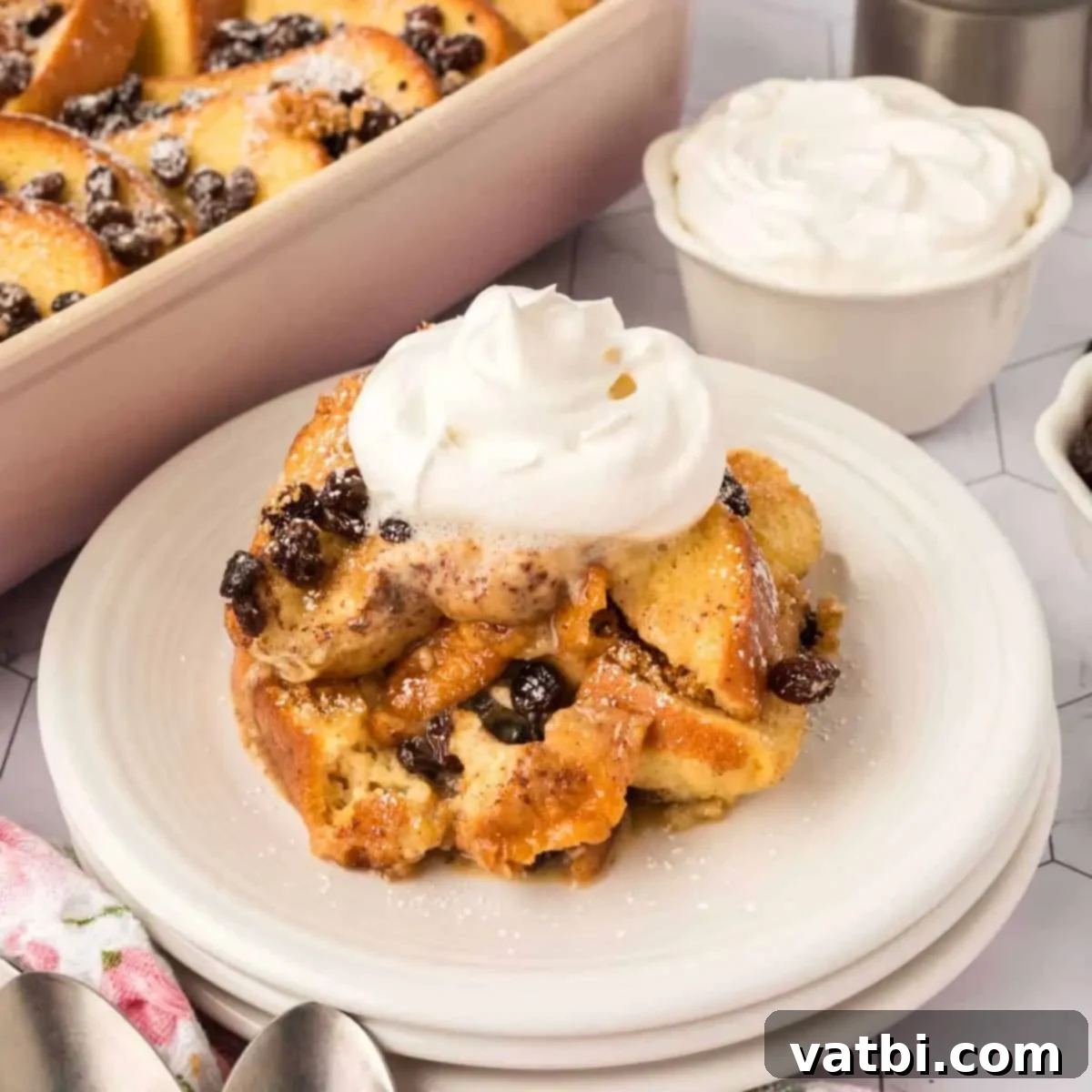Ultimate Bread and Butter Pudding Recipe: A Classic Comfort Dessert
Indulge in the timeless charm of a warm, comforting **Bread and Butter Pudding**. This beloved recipe transforms humble ingredients like brioche bread, rich creamy custard, and a hint of warm spices into an irresistible dessert. It’s a classic for a reason – incredibly simple to make, yet always delivers on satisfying, nostalgic flavor and a beautifully soft, golden texture. Perfect for any occasion, from a cozy family dinner to a festive holiday gathering, this pudding is guaranteed to become a household favorite.
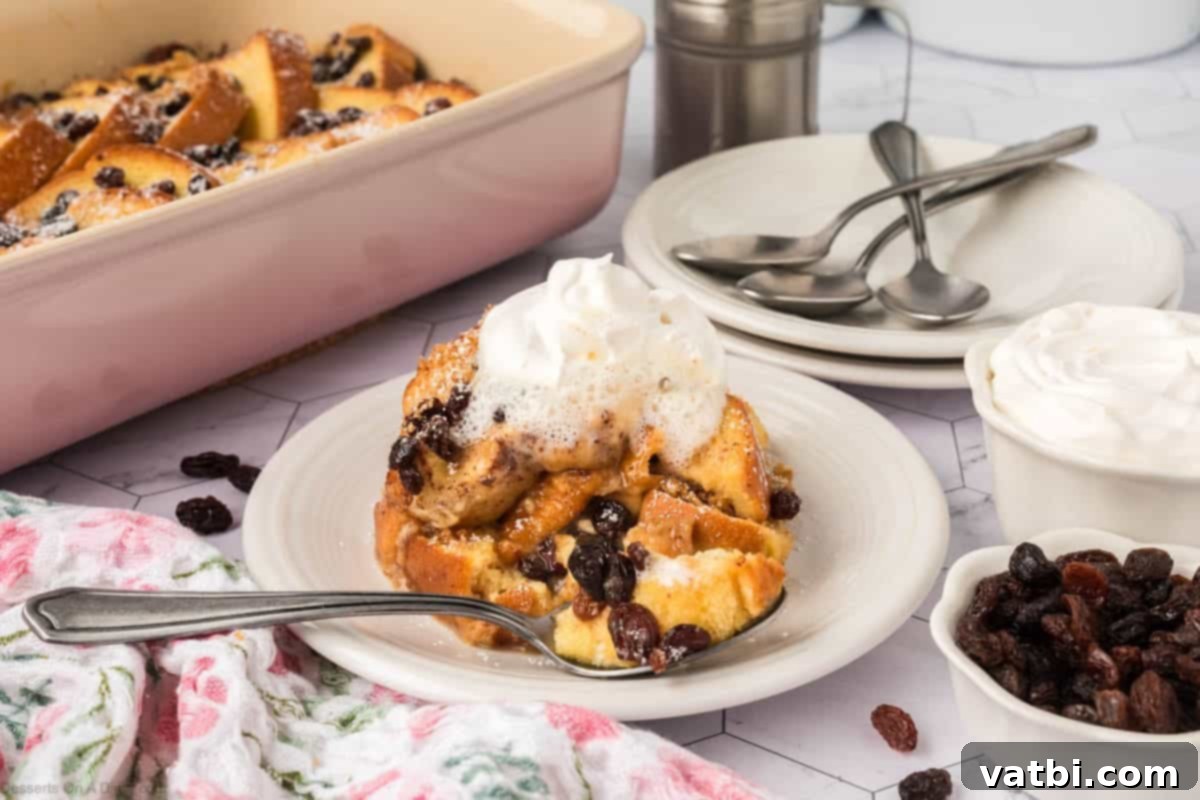
Bread and Butter Pudding stands as a testament to simple, delicious baking. Its origins trace back centuries, a traditional British dessert designed to make the most of stale bread. This version elevates that classic concept, layering slices of generously buttered bread within a luscious, sweet custard. As it bakes, the bread absorbs the custardy goodness, becoming wonderfully soft inside while developing delightful golden, slightly crispy edges. The result is a dessert that evokes warm memories and delivers pure comfort with every spoonful.
This recipe is not only incredibly delicious but also wonderfully practical, serving as a fantastic way to utilize leftover bread, minimizing food waste. It calls for just a handful of staple ingredients that you likely already have in your pantry and refrigerator, making it an accessible treat to whip up anytime. Whether you prefer it served piping hot, straight from the oven, or enjoy it chilled as a delightful snack the next day, this Bread and Butter Pudding never fails to impress. If you’re a fan of comforting bread desserts, you might also love our Cinnamon Roll Bread Pudding for another sweet twist on a classic.
What’s in this post: Bread and Butter Pudding Recipe
- Why We Love This Recipe
- Key Ingredients for Success
- Delicious Variations & Customizations
- Easy Step-By-Step Instructions
- Serving Suggestions
- Storage & Reheating Tips
- Expert Recipe Tips
- Frequently Asked Questions (FAQs)
- More Easy Bread Pudding Recipes
- Bread and Butter Pudding Recipe Card
Why We Love This Recipe
- Simple Comfort Food – This recipe uses everyday pantry staples, making it incredibly easy to prepare and accessible for any home cook. The blend of simple ingredients creates a dessert that offers pure, heartwarming comfort, perfect for a cozy evening or a gathering with loved ones. It’s a nostalgic dessert that brings back cherished memories of home-cooked goodness.
- Budget-Friendly – Bread and Butter Pudding is a brilliant solution for using up slightly stale bread, preventing food waste while creating something truly delicious. Instead of discarding leftover bread, you can transform it into an impressive dessert, saving money and making the most of your ingredients.
- Perfect Texture – The magic of this pudding lies in its harmonious textures. Each bite offers a creamy, tender custard filling contrasted beautifully with buttery, golden-brown bread edges that provide a delightful chewiness. This combination ensures a satisfying sensory experience that keeps you coming back for more.
- Easily Customizable – This recipe serves as a wonderful base for your creativity. While it’s delightful on its own, you can easily personalize it with your favorite mix-ins like juicy raisins, decadent chocolate chips, or a luscious caramel drizzle. The possibilities are endless, allowing you to tailor it to your taste or the season.
- Great for Any Occasion – Whether you’re looking for a fuss-free dessert for a weeknight family meal or an elegant, crowd-pleasing treat for a festive holiday celebration, this bread and butter pudding fits the bill. Its comforting nature and adaptable presentation make it suitable for a wide range of events.
Key Ingredients for Success
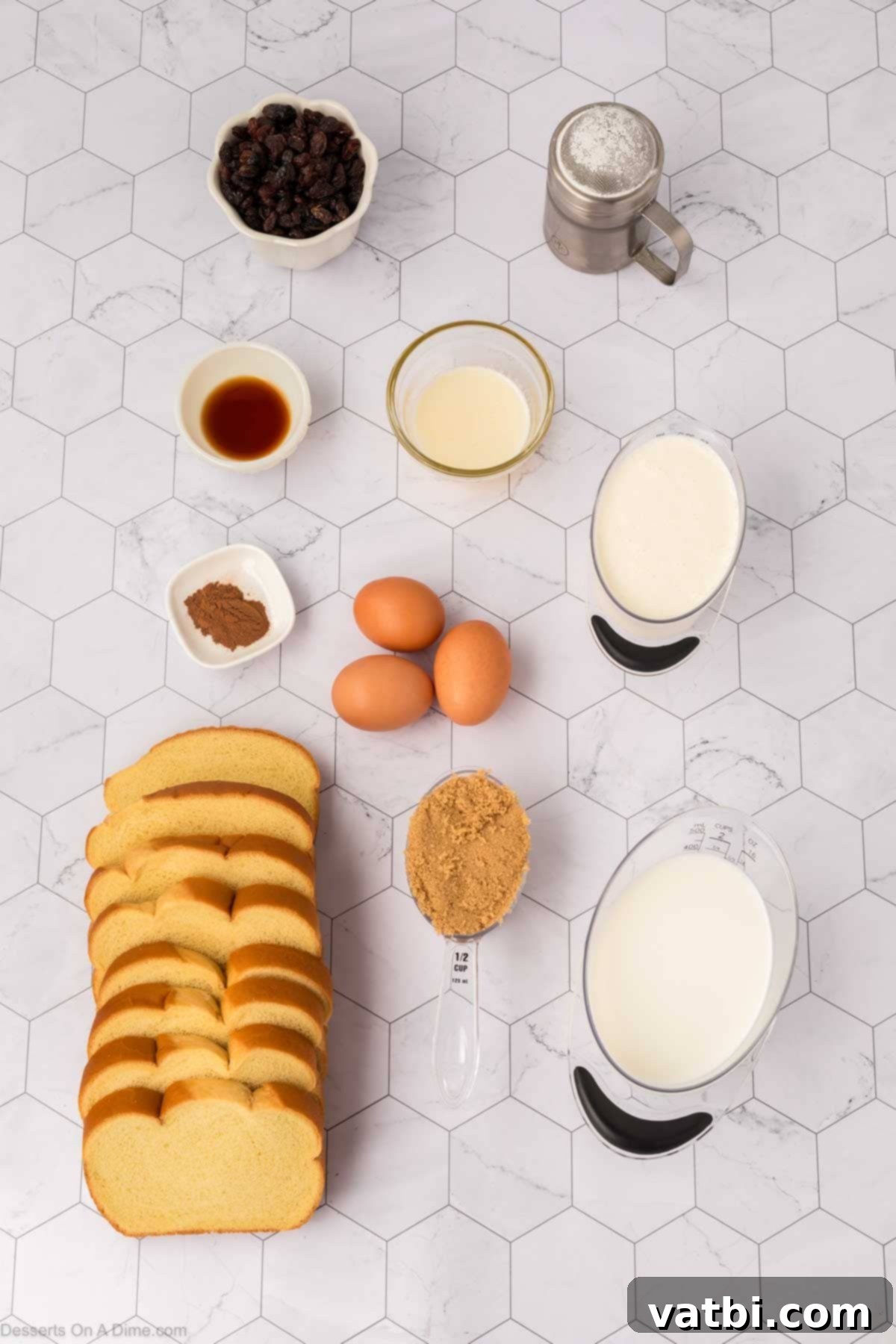
- Brioche bread, cut into triangles – This rich, buttery, and slightly sweet bread is the ideal choice for bread pudding. Its soft crumb readily absorbs the custard, resulting in an exceptionally tender and flavorful base that elevates the entire dish. Using slightly stale brioche is even better, as it absorbs the liquid without becoming soggy.
- Unsalted butter, melted – Brushing the bread with melted butter before baking adds another layer of richness and ensures those coveted golden-brown, slightly crisp edges that are so characteristic of a great bread pudding. It also contributes to the overall moisture and flavor.
- Raisins – These classic additions provide bursts of natural sweetness and a delightful chewy texture that complements the soft pudding. You can plump them in warm water or rum for an extra layer of flavor before adding them.
- Eggs – Essential for creating the creamy custard, eggs act as the primary binder. They give the pudding its structure and contribute to its rich, smooth consistency when baked.
- Whole milk – This forms the liquid base of our custard, balancing the richness of the cream and eggs. Whole milk is preferred for its higher fat content, which contributes to a creamier, more luxurious custard.
- Heavy cream – For an undeniably indulgent and velvety-smooth custard, heavy cream is a must. It adds significant richness and a luxurious mouthfeel that makes this dessert truly special.
- Light brown sugar – Sweetens the custard while imparting a subtle, warm caramel flavor. Light brown sugar is preferable to white sugar here, as its molasses content adds depth and moisture to the pudding.
- Pure vanilla extract – A foundational flavor enhancer, vanilla extract brings a warm, aromatic, and cozy note to the pudding, complementing the other sweet and spicy elements. Always opt for pure vanilla for the best flavor.
- Ground cinnamon – This spice infuses the pudding with a comforting warmth and a delightful aroma. Cinnamon is a traditional pairing with bread puddings, adding a subtle spicy kick that enhances the overall flavor profile.
- Confectioners’ sugar, for dusting – A light dusting of powdered sugar (confectioners’ sugar) provides a beautiful, elegant finish and a touch of extra sweetness before serving. It melts slightly when sprinkled on warm pudding, creating a delicate glaze.
Delicious Variations & Customizations
One of the best things about Bread and Butter Pudding is how easily it can be adapted to suit your taste or what you have on hand. Don’t be afraid to experiment!
- Chocolate Chip Delight – For a richer, sweeter, and undeniably crowd-pleasing twist, swap out the raisins for a cup of your favorite chocolate chips (dark, milk, or even white chocolate work wonderfully). The chocolate melts into gooey pockets within the warm pudding.
- Berry Burst Twist – Introduce a vibrant, fruity, and slightly tangy balance by adding fresh or frozen blueberries, raspberries, or sliced strawberries between the bread layers. These berries burst with flavor as they bake. Alternatively, dried fruits like cranberries, cherries, or diced apricots offer a chewier texture and concentrated sweetness.
- Nutty Crunch – For an added layer of texture and nutty flavor, sprinkle a handful of chopped pecans, almonds, or walnuts between the bread layers. Toasting the nuts lightly beforehand can enhance their flavor even further.
- Citrus Zest – Brighten up the pudding with a fresh, zesty note by mixing in the finely grated zest of one orange or lemon into the custard mixture. The citrus aroma and flavor provide a lovely contrast to the richness.
- Caramel Drizzle – Instead of a simple dusting of confectioners’ sugar, elevate your pudding by drizzling it with warm homemade or store-bought caramel sauce just before serving. A butterscotch sauce would also be divine.
- Different Bread Choices – While brioche is fantastic, don’t limit yourself! You can successfully use other types of bread. Classic white bread, challah, or even day-old croissants or panettone can create delicious variations. French bread or sourdough (for a less sweet, more complex flavor) are also excellent options. Ensure the bread is slightly stale for optimal custard absorption.
- Spiced Up – Enhance the spice profile by adding a pinch of nutmeg, cardamom, or a touch of allspice to the custard for an even warmer, more complex flavor.
- Boozy Bliss – For an adult-friendly version, soak the raisins in a tablespoon or two of rum, brandy, or bourbon for at least 30 minutes before adding them to the pudding. You can also add a splash of liqueur to the custard mixture.
Easy Step By Step Instructions
Making this classic bread and butter pudding is surprisingly straightforward. Follow these simple steps for a dessert that’s sure to impress!
- Step 1. Prepare Your Baking Dish – Begin by preheating your oven to 350 degrees Fahrenheit (175°C). Then, take a 9×13 inch ovenproof baking dish and spray it thoroughly with cooking spray. Make sure to coat the bottom and all sides of the baking dish very well to prevent sticking and ensure easy serving.

Step 2. Arrange the Bread – Next, take your brioche bread slices and cut them diagonally to create appealing triangular shapes. Carefully arrange these bread triangles in a single layer (or slightly overlapping if needed) in your prepared baking dish. You want to ensure an even distribution for optimal custard absorption.
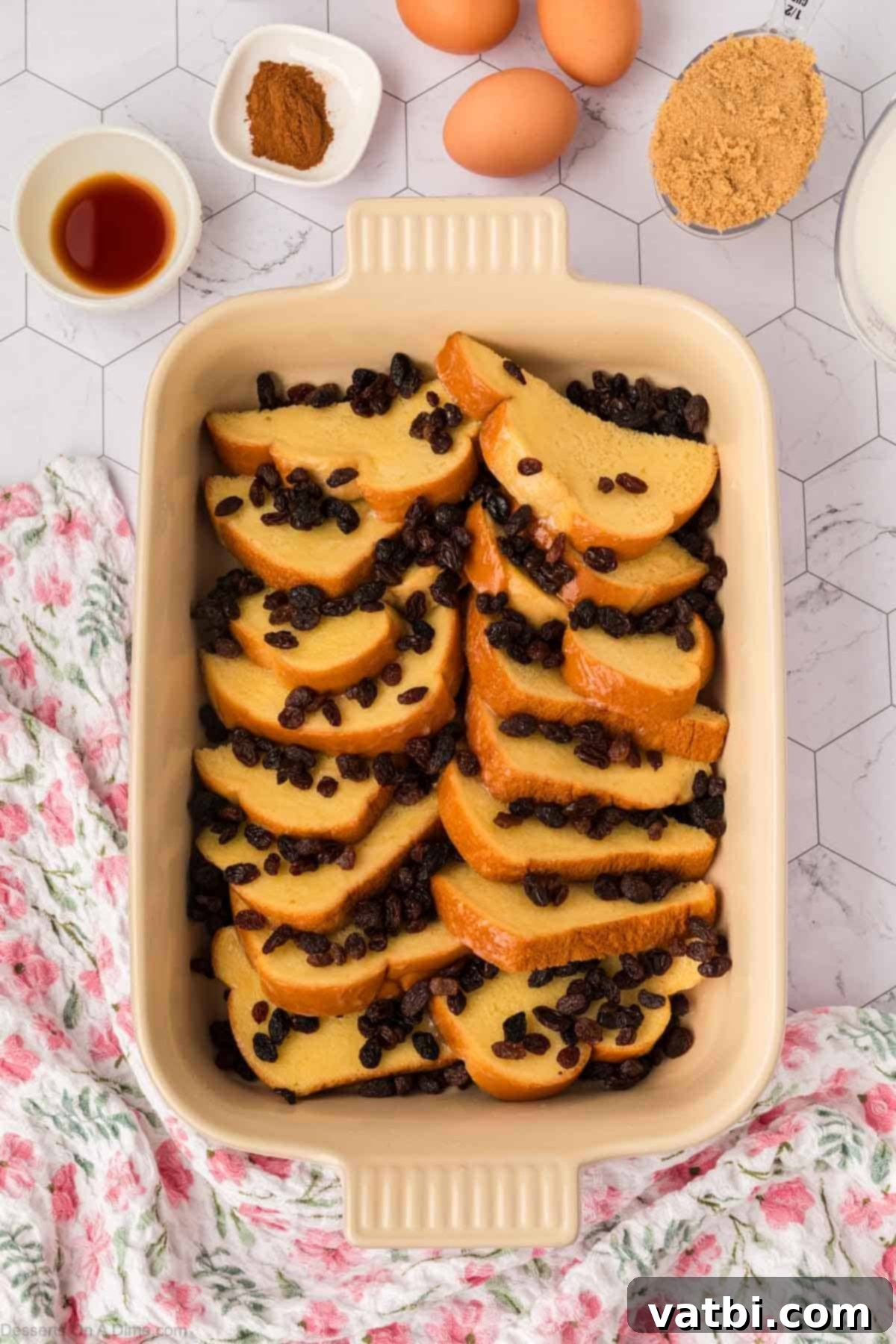
Step 3. Butter and Sweeten the Bread – Melt the unsalted butter until fully liquid. Using a pastry brush, lightly brush each slice of arranged bread with the melted butter. This adds flavor and helps create a lovely golden crust. Then, generously sprinkle the raisins over the buttered bread slices, followed by an even sprinkle of the light brown sugar. This ensures sweetness is distributed throughout.

Step 4. Prepare the Custard Mixture – In a large mixing bowl, crack the eggs and whisk them thoroughly until they are well blended and slightly frothy. This ensures a smooth custard. Then, add the whole milk, heavy cream, pure vanilla extract, and ground cinnamon to the bowl. Whisk all the ingredients together vigorously until the mixture is completely smooth and evenly combined.

Step 5. Combine and Soak – Once your rich custard mixture is perfectly combined, carefully pour it evenly over the layered bread in the baking dish. Gently press down on the bread slices with a spoon or spatula to ensure they are fully submerged and absorb the custard. Allow the bread to soak for at least 10-15 minutes at room temperature before baking, or even longer (up to 30 minutes) for a truly tender result.
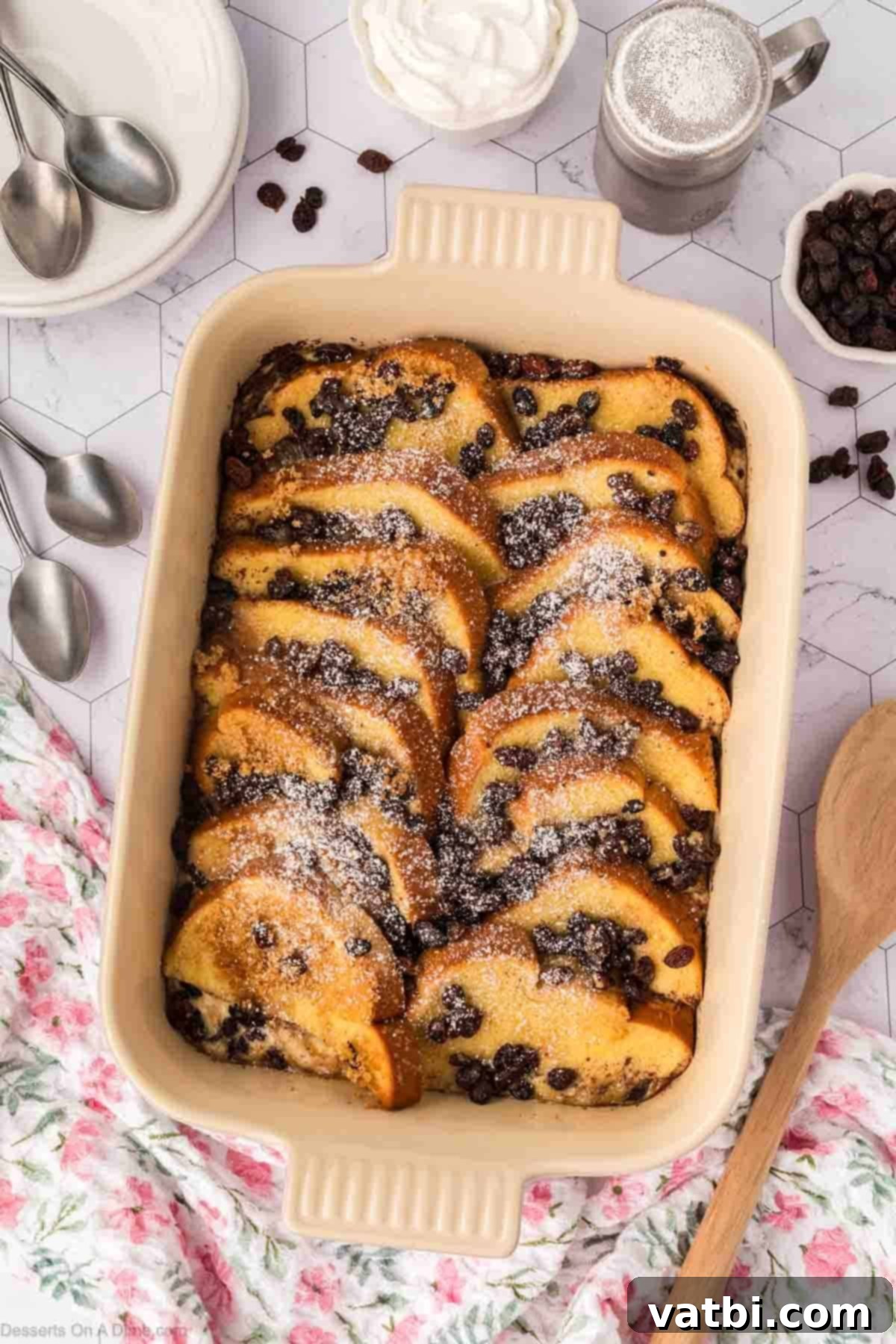
Step 6. Bake to Golden Perfection – Transfer the baking dish to your preheated oven. Bake for approximately 25-35 minutes, or until the top of the pudding is beautifully golden brown and the center appears set. To test for doneness, gently insert a small knife or toothpick into the center; it should come out mostly clean, though the center may still have a slight, delicate wobble. This indicates a perfectly creamy texture without being overbaked.

Step 7. Garnish and Serve – Once baked, remove the pudding from the oven and let it cool slightly for a few minutes. While still warm, dust it generously with confectioners’ sugar for an elegant finish. Serve individual portions warm, and for an extra touch of indulgence, consider adding a dollop of whipped cream, a scoop of vanilla ice cream, or a drizzle of warm caramel sauce. Enjoy this delightful comfort dessert!
Serving Suggestions
Bread and Butter Pudding is a fantastic dessert on its own, but it truly shines with a few thoughtful additions:
- Classic Custard: A warm, velvety vanilla custard is the quintessential pairing for bread and butter pudding. Its smooth texture and complementary flavor enhance the richness of the pudding.
- Whipped Cream: A generous dollop of freshly whipped cream adds a light, airy contrast and a touch of elegance. You can sweeten it lightly and add a splash of vanilla.
- Vanilla Ice Cream: For a delightful hot-and-cold experience, serve warm bread pudding with a scoop of premium vanilla bean ice cream. The melting ice cream creates a luscious sauce.
- Fruit Coulis: A tangy berry coulis (raspberry or strawberry) can cut through the richness of the pudding, adding a fresh, fruity dimension.
- Caramel or Butterscotch Sauce: Drizzle warm caramel or butterscotch sauce over each serving for an extra layer of sweetness and a sticky, decadent finish.
- Fresh Berries: Garnish with fresh raspberries, blueberries, or sliced strawberries for a pop of color and natural freshness.
- Dusting of Cinnamon or Nutmeg: A final sprinkle of ground cinnamon or nutmeg can enhance the warm spice notes already present in the pudding.
Storage & Reheating Tips
Bread and Butter Pudding is fantastic freshly baked, but leftovers are also a delicious treat. Proper storage ensures you can enjoy it for days to come.
- Refrigerator – To store leftovers, first allow the bread pudding to cool completely to room temperature. This prevents condensation from forming and making the pudding soggy. Once cool, cover the entire baking dish tightly with plastic wrap or aluminum foil. Alternatively, transfer individual portions into airtight containers. Stored this way, the pudding will keep beautifully in the refrigerator for up to 4 days.
- Freezer – If you wish to store the pudding for a longer period, freezing is an excellent option. Again, ensure the pudding is completely cooled. For best results, wrap individual portions tightly in plastic wrap, then an additional layer of aluminum foil to prevent freezer burn. You can also place portions or the whole pudding (if in a freezer-safe dish) in a freezer-safe container. Freeze for up to 2 months. Thaw overnight in the refrigerator before reheating.
- Reheating –
- **Oven:** For the best texture, reheat leftover bread pudding in a preheated oven at 350°F (175°C) for about 15–20 minutes, or until warmed through. Covering it with foil for the first part of reheating can help prevent the top from drying out, then remove the foil for the last few minutes if you want to crisp up the edges.
- **Microwave:** For quick reheating of individual portions, the microwave works well. Heat in short 30-60 second intervals, stirring gently between, until heated through. Be careful not to overheat, as this can make the pudding tough.

Expert Recipe Tips for the Perfect Pudding
Achieving a truly outstanding Bread and Butter Pudding is simple with these expert tips:
- Use Slightly Stale Bread – This is a crucial tip! While fresh brioche is delicious, slightly stale bread (day-old bread is perfect) works best for bread pudding. Stale bread is firmer and has a better ability to absorb the rich custard mixture without turning soggy during baking. If your bread is too fresh, you can lightly toast it in the oven for a few minutes to dry it out slightly.
- Butter Generously – Don’t skimp on the butter! Ensure each slice of bread is adequately coated in melted butter. This not only adds incredible richness and flavor but also helps the bread toast beautifully, giving you those coveted golden, slightly crisp edges and a tender interior.
- Allow for Soaking Time – After pouring the custard over the bread, let it sit for at least 10-15 minutes (or even up to 30 minutes) before baking. This soaking time allows the bread to fully absorb the liquid, ensuring a uniformly moist and tender pudding with no dry spots.
- Check for Doneness Carefully – The pudding should be golden brown on top and feel set in the center. When tested with a knife or toothpick inserted into the middle, it should come out mostly clean. A slight wobble is perfectly fine and indicates a wonderfully creamy texture. Overbaking can lead to a dry or rubbery pudding.
- Don’t Overcrowd the Dish – Ensure the bread layers are arranged comfortably in the baking dish without being overly packed. This allows the custard to penetrate all layers evenly and ensures proper baking.
- Adjust Sweetness to Taste – The amount of brown sugar can be adjusted based on your preference. If your bread is already sweet (like brioche or challah) or you plan to add sweet toppings, you might slightly reduce the sugar in the custard.
- Room Temperature Ingredients – Using eggs, milk, and cream at room temperature helps them combine more smoothly with the other ingredients, creating a more uniform custard base.
Frequently Asked Questions (FAQs)
Got questions about making the perfect Bread and Butter Pudding? We’ve got answers!
- Q: What kind of bread is best for bread and butter pudding?
A: While brioche is highly recommended for its richness and texture, you can use a variety of breads. Challah, day-old white bread, French bread, or even stale croissants work wonderfully. The key is to use bread that is slightly stale (day-old) as it absorbs the custard better without becoming too mushy. If your bread is too fresh, you can lightly toast it to dry it out. - Q: Can I make bread and butter pudding ahead of time?
A: Yes, you can! You can assemble the pudding (layer the bread, butter, raisins, and pour over the custard) and let it soak in the refrigerator for a few hours or even overnight before baking. This can deepen the flavors and ensure maximum absorption. Just remember to bring it close to room temperature before baking for even cooking. - Q: How do I know when my bread pudding is cooked?
A: Your bread pudding is cooked when the top is golden brown and the center is mostly set. A slight wobble in the very center is desirable, indicating a creamy texture. If you insert a thin knife or toothpick into the center, it should come out mostly clean. Avoid overbaking, as this can lead to a dry or rubbery pudding. - Q: Can I use frozen berries in my bread pudding?
A: Absolutely! Frozen berries can be added directly to the pudding without thawing. They will release some moisture as they bake, which can add to the pudding’s moistness. If you prefer to minimize excess liquid, you can gently toss them with a tablespoon of flour before adding. - Q: What can I use if I don’t have heavy cream?
A: If heavy cream isn’t available, you can substitute it with half-and-half for a slightly lighter but still creamy result. You could also use an additional cup of whole milk, though the pudding will be less rich and indulgent. - Q: My bread pudding turned out soggy. What went wrong?
A: A soggy pudding often indicates that the bread didn’t have enough time to dry out (was too fresh) or it was over-soaked without being baked quickly enough, leading to over-saturation. Ensure your bread is slightly stale and don’t let it sit in the custard for an excessively long time if you prefer a firmer texture. Also, ensure your oven temperature is accurate and the pudding bakes fully.
More Easy Bread Pudding Recipes
- Pineapple Bread Pudding
- Pumpkin Bread Pudding
- Peach Bread Pudding
We invite you to try this delightful classic Bread and Butter Pudding today. Its warm, comforting embrace and rich flavors are sure to make it a cherished dessert for your entire family. After you’ve whipped up this fantastic dish, please don’t hesitate to leave a comment and share your thoughts with a star rating. We love hearing from you!
Pin
Bread and Butter Pudding
Ingredients
- 8 slices brioche bread cut into triangles
- 4 tablespoons unsalted butter melted
- 1 cup raisins
- 3 large eggs
- 1 ½ cups whole milk
- 1 cup heavy cream
- ½ cup packed light brown sugar
- 1 teaspoon pure vanilla extract
- 1 teaspoon ground cinnamon
- 1/4 cup confectioners’ sugar for dusting
Instructions
-
Preheat the oven to 350°F (175°C). Spray a 9×13 inch baking dish generously with cooking spray, ensuring all sides are coated.
-
Cut the brioche bread diagonally into triangles and arrange them neatly in a single layer in the prepared baking dish.
-
Lightly brush each bread slice with the melted unsalted butter, ensuring good coverage for rich flavor and golden edges.
-
Sprinkle the raisins evenly over the buttered bread, then follow with an even layer of light brown sugar.
-
In a large mixing bowl, whisk the eggs until well blended and slightly frothy. Add the whole milk, heavy cream, pure vanilla extract, and ground cinnamon. Whisk until the mixture is completely smooth and all ingredients are combined.
-
Pour the prepared custard mixture evenly over the layered bread in the baking dish. Gently press the bread down to ensure it absorbs the custard. Allow to soak for 10-15 minutes at room temperature.
-
Bake for approximately 25-35 minutes, or until the top is golden brown and the center is set but still slightly wobbly when gently nudged. Test with a small knife or toothpick – it should come out mostly clean.
-
Remove from oven, let cool slightly. Finish with a generous dusting of confectioners’ sugar and serve warm. Enjoy this comforting dessert with your favorite toppings like whipped cream or ice cream!
Recipe Notes
Freezer: Wrap cooled portions tightly in plastic wrap and then foil, or place in a freezer-safe container. Freeze for up to 2 months. Thaw overnight in the refrigerator before reheating.
Reheating: For best results, reheat in a 350°F (175°C) oven for 15-20 minutes, covered with foil. Microwave individual portions in short bursts until warm.
Nutrition Facts
Pin This Now to Remember It Later
Pin Recipe
